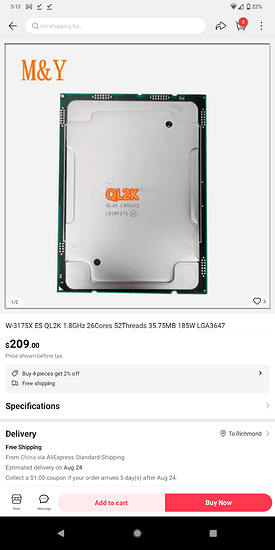Hello good people of Level1.
This is my first post here and I do feel a bit bad for immediately asking for help without really contributing before. A bit of backstory:
The last desktop PC I’ve built was way back in 2007. A lot has changed since then and I have followed the industry on and off since. Unfortunately I’ve been stuck with crappy laptops since 2013 and I am tired of it. Congratz to anyone that can get quality work done with a laptop, I guess I am not that kind of person.
But anyway, life has been financially kind to me in recent times and I’m looking to build a powerful desktop / workstation. I am not the type of guy that upgrades every 1-2 years. Ideally for my use case I would like a computer that can serve me well for 4-5 years before I get rid of it and build a completely new system.
This machine will be using Linux as the daily driver with a Windows VM that will see very light usage. In fact I’m not even sure if the VM will be allowed to connect to the internet at all. Just some light Photoshop / Illustrator use and a couple of old games that don’t play well with Linux if any.
I need it to work great with Davinci Resolve (no crazy editing shenanigans, I just want it blazing fast while editing and rendering) and Youtube / Twitch live streams (not streaming games). Another thing that is very important to me is that I can utilize my Sony FW900 monitor for content like games and movies. For those of you who appreciate CRTs, you know where I’m coming from.
The monitor works flawlessly in 19200x1200 (16:10 AR) at 95Hz. So games should be locked at 95Hz unless I can find a way to make it work in interlaced mode with higher refresh rates. Have not yet tried this with Linux + AMD gpu since I don’t own an AMD gpu.
Of course I will have a modern display attached to it as well for browsing / resolve / other work.
I am pretty set on most components except for the platform. I have no interest in the newest things like AM5 and Z790 until they get really optimized and stable.
I understand that it is 4 years old by now, but I am in awe of the Xeon 3175 + EVGA SR-3 dark combo. It seems so well built and so durable and stable. I might be wrong about this so please let me know if it’s a bad idea and why. The MBO can be snatched for $500 new at certain places and the CPU is about $800-1000 used. Maybe Wendell would sell his setup? ![]()
This platform would allow me to have a bunch of PCIe lanes and hexa channel memory. Would help immensely with GPU passthrough for the VM (2nd GPU), a bunch of storage options so that I can delay building a home server for some time, and a bunch of RAM that’s stable.
Another option is to go with AM4, specifically the 5950x with a premium MBO. This is a tried and tested platform with very little problems I guess but then we end up with PCIe shortage sooner or later. However this thing doesn’t really require a custom loop to run daily. The Xeon probably does if I OC it to, say, 4Ghz and keep it that way 24/7. If I can air cool the Ryzen and have it run great in a good ventilated case that’s a big plus for me.
The rest of the components:
GPU: Asrock OC Formula 6900 (or 6950) XT (2x most likely)
RAM: at least 128GB DDR4
Storage: 1 x system OS NVMe and then as many sata drives as I can fit (looking for recommendations on both)
Case: either Lian Li D-EVO XL when it comes out or the Fractal Torrent
PSU: something top of the line like the Corsair HX/AX series 1200+
Cooling: prefereably air or AIO because at this point I can’t bring myself to build a custom loop and all the maintenance that goes with it
Sorry for the long post but hopefully this explains what I am looking for.
tl;dr building a new workstation with premium parts, something stable and durable, and can’t decide between Xeon 3175x or AM4 platform. need proper non-reddit advice from people who know better.
Thank you all for taking the time to read this.


